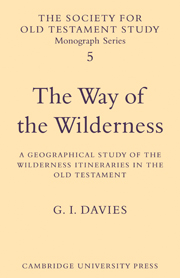Book contents
- Frontmatter
- Contents
- Preface
- Abbreviations
- Maps
- 1 Introduction
- 2 Jewish interpretations in Greek
- 3 Jewish interpretations in Hebrew and Aramaic
- 4 Christian interpretations
- 5 Arabic interpretations
- 6 Behind the traditions
- 7 Key points on the routes
- 8 Routes in the Sinai Peninsula
- 9 Identification of the routes described
- Notes to the text
- Bibliography and Author Index
- Indexes
9 - Identification of the routes described
Published online by Cambridge University Press: 04 August 2010
- Frontmatter
- Contents
- Preface
- Abbreviations
- Maps
- 1 Introduction
- 2 Jewish interpretations in Greek
- 3 Jewish interpretations in Hebrew and Aramaic
- 4 Christian interpretations
- 5 Arabic interpretations
- 6 Behind the traditions
- 7 Key points on the routes
- 8 Routes in the Sinai Peninsula
- 9 Identification of the routes described
- Notes to the text
- Bibliography and Author Index
- Indexes
Summary
It is now possible, in the context provided by the preceding chapters, to examine the primary wilderness itineraries (Num. 21: 12–20; Num. 33: 1–49; Dt. 10: 6–7; and the itinerarynotes of P) one by one, in the hope of establishing the routes to which they refer. We begin with the fullest and longest text, Num. 33: 1–49. The three points already used to define the general outline of the route can also serve to divide it into four sections which can be studied separately.
RAMESES–YAM SUF
The first two places in the itinerary (prior to Etham ‘on the edge of the wilderness’) are generally agreed to have been in the eastern Nile delta and have been located with considerable precision on the basis of apparent references to them in Egyptian texts. Rameses is usually taken to be identical with Pr-rmśśw, the Ramesside city in the delta, which most scholars now locate at Qantir or at the neighbouring site of Tanis (San el-Hajar). An Egyptian equivalent also seems to exist for Succoth in Ṯkw, a name of an area in Wadi Tumilat which extends west from modern Ismailia, and just conceivably the Egyptian name for Tell el-Maskhuta there, to which ‘Pithom’ in Ex. 1: 11 is likely to refer. But some scholars regard ‘Succoth’ as a true Semitic name meaning ‘booths’ (compare the place of this name in central Transjordan (Gen. 33: 17 etc.)), in which case only its general location in the border area infiltrated by nomads can be fixed.
- Type
- Chapter
- Information
- The Way of the WildernessA Geographical Study of the Wilderness Itineraries in the Old Testament, pp. 79 - 93Publisher: Cambridge University PressPrint publication year: 1979



